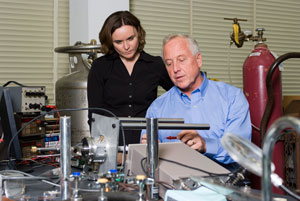
In the realm of subatomic particle acceleration, rings take centerstage. The world’s most powerful proton-antiproton collider in the United States is the circular Tevatron, located underground at Fermilab, in Batavia, Ill., while the 27-kilometer-in-circumference Large Hadron Collider, near Geneva, Switzerland, is the world’s largest and highest-energy particle accelerator.
But rings aren’t right for every situation in particle physics, says John Zasadzinski, IIT professor of physics. Colliding electrons produce cleaner data than colliding protons, but electrons lose their speed when bent in a ring by emitting radiation in the form of X-rays and are therefore most optimally collided in a linac, or linear accelerator. And unlike rings, linacs can produce a nearly continuous high-energy stream of particles that can be directed, for example, at a tumor, providing a more targeted mode of destruction than radiation therapy.
Zasadzinski, along with Sandra Bishnoi and Brant Cage, assistant professors of chemistry, are members of a global team working on the successor to the Large Hadron Collider, namely, the International Linear Collider, currently under design. Funded by a three-year federal grant through Fermilab and Argonne National Laboratory, the three researchers are performing surface-sensitive probe analyses on superconducting radio-frequency cavities, the objects that form the acceleration tunnel through which 20 billion electrons and positrons will zoom to collide at the ILC’s center at a rate of 14,000 times per second. Fermilab has discovered that the cavities are breaking down prematurely during trial runs, putting a halt to the acceleration process. The IIT team is also working with Argonne to characterize and determine the properties of protective coatings that could be applied to the cavity surface.
“What we’re bringing to the table is something new; these are surface probes that neither Fermilab nor Argonne were using,” says Zasadzinski, about the team’s areas of expertise. Zasadzinski, a condensed-matter physicist, is using tunneling spectroscopy to help learn the quality of the surface of the extremely low-electrical resistant element—niobium—that comprises each of the 16,000 cavities that are expected to line the ILC’s two tracks.
Through electron paramagnetic resonance testing, Cage is checking the cavity surface for magnetic properties, which will reduce acceleration and lead to sub-optimal speeds. For her contribution, Bishnoi is employing Raman spectroscopy. Among the most sensitive techniques available in surface science, it can identify individual molecules on the surface of a metal.
“There’s the possibility that the cavity surface is being contaminated or roughened,” says Bishnoi. “Raman can tell us whether or not it’s a pure niobium cavity.”
While it’s still too early in the project to publish their findings, Zasadzinski says that Raman spectroscopy has revealed that the regions of the cavity where breakdown occurs have pitted surfaces that are entirely different from the rest of the cavity.
A fellow of the American Physical Society, Zasadzinski is most fascinated by the juxtaposition of large and small within the ILC itself.
“The proposed accelerator is 19 miles long but what controls how well it works is at the nanometer scale,” he says. “We’re trying to understand and modify surfaces at 40 nanometers to create an object that will be 31 kilometers long, and get it to work.”